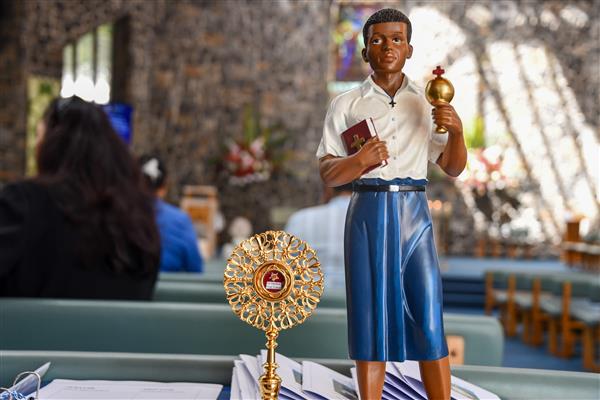
Communities from across Oceania gathered together in Broken Bay on Sunday, to give thanks for the canonisation of Saint Peter To Rot, the first male saint born in our wonderful region of the world.
Bishop Anthony Randazzo, Bishop of Broken Bay and President of the Federation of Catholic Bishops Conferences of Oceania (FCBCO), presided over Mass at Our Lady of the Rosary Cathedral, Waitara, welcoming communities from Fiji, Samoa, Tonga, Papua New Guinea and other Pacific nations.
The Mass began with a procession of the Migrant Jubilee Cross, which is on a year-long national pilgrimage recognising the contributions of Australia’s migrant and refugee communities, a reminder that wherever we go, Jesus must lead the way.
In his homily, Bishop Anthony said Saint Peter To Rot, the first Saint to be born in Papua New Guinea, was a powerful witness to the Gospel, merely by living that faith simply.
"Peter To Rot was not a bishop, priest, or religious. He was a lay catechist, a husband and father, someone who simply took his faith seriously," he said.
"In a time of persecution, he stood firm, faithful to the Gospel he had embraced. His witness reminds us that holiness is not the privilege of a few; it is the call of every baptised person, male or female, young or old. Each of us, in our daily lives, in our families, workplaces, parishes, schools, and communities, is called to be a living witness to Christ."
The celebration also coincided with World Mission Sunday, the day set aside by the Church to publicly renew its commitment to the missionary movements.
Missionaries played a strong role in the life of the Church in Oceania, and particularly in the life of Saint Peter To Rot. He was taught by the Missionaries of the Sacred Heart which inspired his faith in the Gospel and led him to become a catechist in his community.
Peter To Rot was born on 5 March 1912 in then-German New Guinea. Both his parents had converted to Catholicism years before and he was taught the basics of catechism. Despite a local priest suggesting he would make a good priest, Blessed Peter’s father suggested he study to be a catechist instead.
He became a catechist in the local area in 1933 after studying for three years. He married in 1936 and had three children.
When Japanese forces occupied the nation in 1942, they interned all the foreign missionaries, leaving Peter in charge of his local parish. His courageous witness to the faith during these years led him to be imprisoned in a Japanese Prisoner of War Camp, where he would be killed by lethal injection in 1945.
He was declared a Servant of God in 1986 and his beatification received approval in 1993. He was officially beatified by Pope John Paul II in 1995 while on a visit to Papua New Guinea.
His canonisation on Sunday means one of Oceania's own sons is now a powerful witness of faith to the rest of the world.
"My sisters and brothers, as we celebrate this canonisation, let us also welcome Saint Peter To Rot as a companion on our own journey of faith," said Bishop Anthony.
"In many parts of our world today, religion is treated as unnecessary, and faith as something outdated or private. Saint Peter To Rot’s life speaks strongly into this reality. He reminds us that without faith, we are left clinging to the surface of this world, never daring to hope for the joy of heaven.
"In this Holy Year of Hope, his example shines brightly. He teaches us to lift our eyes beyond what is passing, to the One who never disappoints. Hope in Jesus gives us strength to endure and courage to live the Gospel fully."
The Mass concluded with a light lunch in the Cathedral courtyard.
Read Bishop Anthony Randazzo's homily from the Mass in full here.